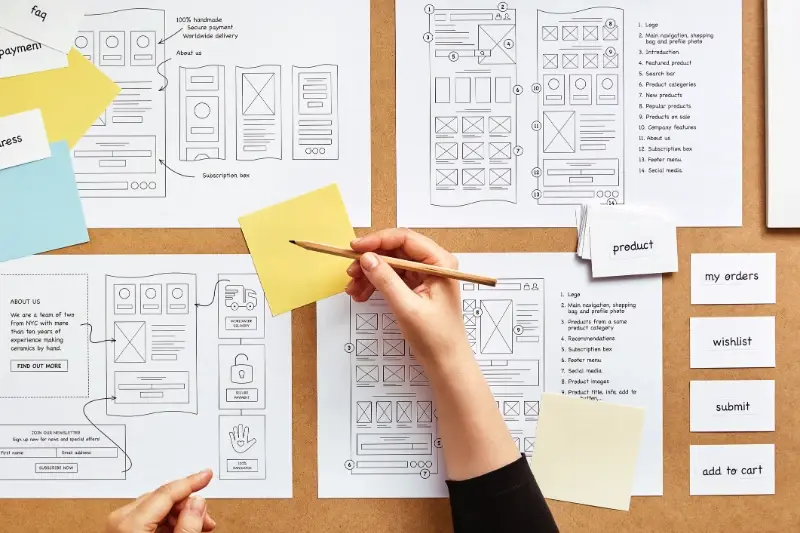App Feasibility Mistakes That Cost Developers Millions
I've been working in mobile app development for over eight years now, and I've watched countless brilliant ideas crash and burn because someone skipped the feasibility study or made critical errors during the planning phase. These aren't small oversights either—we're talking about mistakes that cost developers millions of pounds and years of their lives.
The most expensive mistake you can make in app development is assuming your idea will work without properly testing whether it actually can or should
The thing is, most of these app development failures are completely avoidable. They happen because developers get caught up in the excitement of their idea and rush straight into building without asking the hard questions first. Can we actually build this with our budget? Will people really use it? Does the technology even exist yet? These feasibility study errors might seem boring compared to designing interfaces or writing code, but they're what separate successful apps from expensive disasters. The good news? Once you know what to look out for, you can avoid these mobile app development costs entirely. Let's break down the biggest mistakes that are costing developers fortunes—and more importantly, how to dodge them.
Skipping Market Research
Here's the thing about market research—most developers think they can skip it because they "know" their app idea is brilliant. I've watched countless projects crash and burn because someone assumed their personal problem was everyone's problem. That assumption can cost you everything.
Market research isn't just about checking if similar apps exist; it's about understanding whether people actually want what you're building and if they're willing to pay for it. You might think your revolutionary fitness tracker is exactly what the world needs, but without proper research, you won't know that people are already overwhelmed with fitness apps and aren't looking for another one.
Understanding Your Competition
When you skip researching competitors, you miss learning from their mistakes and successes. More importantly, you can't figure out how to make your app different or better. I've seen developers spend months building features that already exist in dozens of other apps—features that users don't even use much.
Validating Real Demand
The hardest truth in app development is that most ideas don't have enough market demand to justify the investment. Proper research reveals whether your target audience is large enough, whether they have money to spend, and whether they're actively looking for solutions like yours.
Without this groundwork, you're essentially gambling with your development budget. The apps that succeed aren't always the best ones—they're the ones that solve real problems for people who are ready and willing to pay for solutions.
Underestimating Technical Complexity
Here's where things get really messy—and expensive. I've watched countless brilliant app ideas crash and burn because developers thought building their vision would be straightforward. They'd sketch out their concept on paper, maybe create a few wireframes, then confidently declare it'll take three months to build. Six months later, they're still wrestling with basic functionality whilst their budget has tripled.
The problem isn't that developers are intentionally misleading themselves; it's that modern mobile apps are far more complex than they appear on the surface. That simple photo-sharing app you're planning? It needs user authentication, image compression, cloud storage, push notifications, privacy controls, content moderation, and backup systems. Each of these components brings its own technical challenges.
Common Technical Oversights
The most frequent mistakes happen when teams focus only on the main features whilst ignoring the supporting infrastructure. They'll spend weeks perfecting the user interface but forget about data synchronisation between devices. Or they'll build amazing core functionality without considering how it'll handle thousands of simultaneous users.
- Database architecture and data migration needs
- Third-party API integrations and their limitations
- Security requirements and compliance standards
- Cross-platform compatibility issues
- Performance optimisation for different devices
- Offline functionality and data caching
Always build in a 40-60% buffer on technical estimates. Complex features often require twice as long as initially predicted, especially when integrating multiple systems or handling edge cases that weren't obvious during planning.
The smartest approach is breaking your app down into its smallest technical components during the feasibility stage. Map out every API call, every database interaction, every user permission—then research the complexity of each one. This granular approach reveals the true scope of your project before you've committed serious money to development.
Ignoring Platform Requirements
Every platform has its own set of rules, guidelines, and technical requirements—and ignoring them is one of the fastest ways to watch your budget disappear. Apple's App Store and Google Play Store don't just have different approval processes; they have completely different expectations for how apps should look, feel, and function.
I see developers make this mistake all the time. They build an app for iOS and think they can just port it over to Android without any changes. Wrong! Android users expect different navigation patterns, different button placements, and different visual styles. What works perfectly on an iPhone might feel clunky and foreign on a Samsung Galaxy.
The Cost of Platform Blindness
When you ignore platform requirements, you're setting yourself up for expensive redesigns and lengthy approval delays. Apple might reject your app because it doesn't follow their Human Interface Guidelines. Google might flag your app for not properly implementing Material Design principles. These rejections don't just cost time—they cost money whilst your development team scrambles to fix issues that should have been addressed from day one.
Technical Requirements Matter Too
Beyond design guidelines, each platform has specific technical requirements. iOS apps need to support different screen sizes and orientations; Android apps need to work across thousands of different devices with varying specifications. Memory management works differently on each platform, and so do push notifications, in-app purchases, and data storage.
The smart approach? Plan for platform-specific requirements from the beginning. Budget for separate design work for iOS and Android. Factor in extra development time for platform-specific features. Your wallet will thank you later when you're not paying for emergency redesigns and resubmissions.
Poor Budget Planning
I've seen more app projects crash and burn because of money problems than any other single reason. It's heartbreaking really—brilliant ideas that never see the light of day because someone got their sums wrong from the start. Most people think budgeting is just about adding up development costs, but that's where the trouble begins.
The biggest mistake? Forgetting about everything that happens after you build the app. Marketing, app store fees, server costs, ongoing maintenance—these aren't optional extras, they're part of the package. I've watched projects blow through their entire budget during development, leaving nothing for launch or user acquisition. That's like building a shop and having no money left for the grand opening.
Hidden Costs That Bite
Third-party integrations can be budget killers. That payment system you thought was free? It charges transaction fees. Those push notifications? They cost money after the first few thousand. Analytics tools, cloud storage, security certificates—they all add up faster than you'd expect.
We spent 80% of our budget on development and had to launch with basic features because we couldn't afford the integrations we'd originally planned
The 50% Rule
Here's what works: take your development estimate and add 50% on top. Not for the development itself, but for everything else. Post-launch updates, bug fixes, marketing, and those inevitable "just one more feature" requests. Trust me on this one—apps that survive their first year are the ones with realistic budgets that account for the long game, not just the build phase.
Overlooking User Testing
User testing is one of those things that sounds obvious when you say it out loud, but you'd be shocked at how many developers skip it entirely. I get it—you've spent months perfecting your app concept, the code is clean, and everything works exactly as you planned. But here's the problem: what works for you might be completely baffling to your actual users.
The scary part is that user testing isn't just about finding bugs (though it does that too). It's about discovering whether people can actually use your app the way you intended. I've seen apps that were technically perfect but completely failed because users couldn't figure out how to complete basic tasks. One tap that seems logical to you might confuse everyone else.
When Testing Goes Wrong
The most expensive mistake happens when developers test their apps only with people who already understand the product—team members, friends, or family who've heard about the app concept dozens of times. These people aren't real users; they're biased testers who already know what the app is supposed to do.
Real user testing means putting your app in front of complete strangers and watching them struggle. Yes, it's painful to watch someone get confused by something you think is simple, but that pain saves you from much bigger problems later.
The Cost of Skipping Testing
Apps that launch without proper user testing often face brutal reviews, high uninstall rates, and expensive redesigns after launch. Fixing these problems post-launch costs roughly ten times more than addressing them during development. The math is simple: a few days of user testing now saves months of emergency fixes later.
Neglecting Scalability Planning
One of the biggest app feasibility mistakes I see developers make is building an app that works perfectly for 100 users but crashes when 10,000 people try to use it. This isn't just about servers—though that's part of it. It's about designing every part of your app to handle growth from day one.
Most developers focus on getting their minimum viable product out the door, which makes sense. But when you completely ignore how your app will cope with success, you're setting yourself up for a very expensive rebuild later on. The database structure that works fine for a few hundred users might grind to a halt with thousands. Your payment system might buckle under heavy traffic. Your user interface might become sluggish when dealing with larger datasets.
Build your app architecture with at least 10x your expected user base in mind. It's much cheaper to plan for scale upfront than to rebuild everything later.
Common Scalability Oversights
- Choosing databases that can't handle concurrent users
- Hard-coding limits that become bottlenecks
- Using cheap hosting that can't grow with demand
- Building APIs that become slow with more data
- Ignoring content delivery networks for global users
The cost of fixing scalability issues after launch can be astronomical. You're not just paying for development time—you're losing users who get frustrated with poor performance, dealing with negative reviews, and potentially missing out on revenue during downtime. Some apps never recover from early scaling problems because users simply move on to competitors.
Smart developers build flexibility into their app architecture from the beginning. This doesn't mean over-engineering everything, but it does mean making thoughtful choices about technology, hosting, and system design that won't paint you into a corner later.
Conclusion
The path from app idea to successful product is littered with expensive mistakes—most of which could have been avoided with proper feasibility planning. I've watched countless developers burn through budgets because they skipped the boring bits at the start. Market research feels tedious when you're excited about your idea, but it's the difference between building something people actually want and creating an expensive digital paperweight.
Technical complexity will always surprise you; that's just the nature of software development. But underestimating it by orders of magnitude? That's on you. The same goes for platform requirements—iOS and Android might seem similar from the outside, but they have their own quirks that can derail your timeline and budget if you're not prepared. Budget planning isn't just about having enough money to build version one; it's about having enough runway to iterate, fix problems, and actually reach your users.
User testing and scalability planning might feel like luxuries when you're trying to get your minimum viable product out the door, but they're investments in your app's future. Every hour you spend testing with real users early on saves you weeks of painful pivots later. Every conversation about scalability now prevents those 3am panic calls when your servers crash under unexpected load.
The mobile app industry is unforgiving, but it's not random. Most failures follow predictable patterns, and most successes share common traits—they all started with solid feasibility analysis. Your brilliant idea deserves better than to become another cautionary tale.
Share this
Subscribe To Our Blog
You May Also Like
These Related Stories

When to Pivot: Reading App Feasibility Warning Signs

Event Management App Features That Actually Make Organisers' Lives Easier





